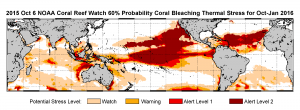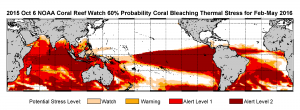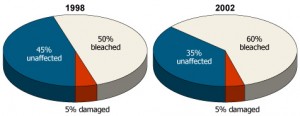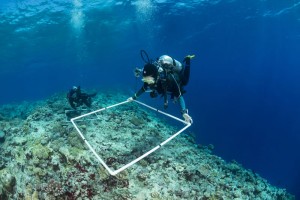When the month of October rolled around in 2015, and El Niño was beginning to bring heavy rains across the western United States, many naive Californians were filled with hope that an end to the state’s four-year drought was in sight. Unfortunately, this reoccurring climate pattern known as the El Niño-Southern Oscillation (ENSO) was causing much greater problems out at sea than on the thirst-driven West Coast.
On October 8th 2015, the National Oceanic and Atmospheric Administration (NOAA) announced the third ever coral bleaching event occurring on a global scale1. One effect of ENSO is the dramatic rise in sea surface temperatures across the Pacific, which causes stress on the dynamic aquatic ecosystems, especially coral reefs. According to the National Aeronautics and Space Administration’s (NASA) Global Climate Change website, there is a direct link between the increased amount of greenhouse gases being emitted to the atmosphere and the Earth’s warming2. Evidence for this global warming includes dramatic increases in the sea level in the past decade, which was nearly double that of the past century3, as well as increases in global surface and oceanic temperatures2. These existing global warming issues coupled with the current El Niño storm perpetuate a harsh environment for coral reefs, and triggered the current mass bleaching event.
But first, how does coral bleaching happen? Coral have a symbiotic relationship with algae, meaning that the two are dependent on each other for survival. The algae, called zooxanthellae, lives inside the coral tissue and gives its host oxygen and other nutrients while the coral gives the zooxanthellae carbon dioxide4. Each organism needs these compounds to live. Under normal conditions, this relationship is very successful and the coral lives a happy and healthy life. When you think of coral reefs, you likely think of a scene out of Pixar’s Finding Nemo, with brilliantly colored corals. The algae are what give corals their beautiful color. Unfortunately, when factors such as temperature are changed, this causes stress on the coral and forces the algae to abandon its host. Without the algae, the coral is left without its partner (and primary source of food), so it turns white and is very vulnerable to disease, which can lead to its death. This phenomenon is known as coral bleaching.
When NOAA announced the global bleaching event in October, the primary areas of concern for being affected in the first stage (October – January 2016) the most were the Hawaiian Islands, Caribbean and the South Pacific, as seen in the picture below. These are the areas in dark red.

NOAA’s map of global projections for areas at high risk for coral bleaching between October and January of 2016. credit: NOAA
At the time, the Great Barrier Reef (GBR), located off the Northeast coast of Australia, was predominantly labeled as a “Warning” zone, so it was at risk but not as severely as other reefs. However, in NOAA’s projections for the February – May 2016 stage of the bleaching event, the GBR is bumped up to Alert Levels 1 and 2.

NOAA’s global map of projections for areas at high risk for coral bleaching between February and May of 2016. credit: NOAA
Unfortunately, this means trouble for the world’s largest coral reef system. The GBR is composed of over 3,000 individual reefs and is one of the most sought destination for travelers across the globe5. There’s a reason this beautiful and unparalleled ecosystem is one of the seven wonders of the natural world. The national marine park covers over 300km (1800 miles) along the coast of Queensland and is home to more than 600 types of coral, 1500 species of tropical fish and 200 types of birds5,6. The GBR is one of Earth’s most treasured natural habitats and it is now in grave danger.

Great Barrier Reef from above. credit: http://d3lp4xedbqa8a5.cloudfront.net/s3/digital-cougar-assets/AusGeo/2013/09/10/5446/great-barrier-reef.jpg
However, this wont be the first time the GBR has experienced coral bleaching. In 1998, during the first ever global coral bleaching event, 16% of the world’s coral reefs were affected while 50% of the reefs on the GBR experienced bleaching7,8. In 2002 there was another mass bleaching event, and this time 60% of the reefs on the GBR suffered bleaching. During each of these events, 5% of the reefs were severely damaged6.
After the 2002 event, the Great Barrier Reef Marine Park Authority (GBRMPA), which oversees the reef, developed a risk and impact assessment plan to respond to bleaching events in the future, like right now. This plan outlines a way to strategically monitor and assess coral bleaching impacts. According to a study conducted by NOAA and the University of Queensland, the current coral bleaching even is expected to be worse than ever before for the GBR7. While the GBRMPA uses their plan on an annual basis to monitor the reefs, it will be of vital importance to document the upcoming changes.
It’s difficult to know how to respond to this kind of news as an individual. It feels like we are just standing idly by, watching the sky turn grey and waiting for the storm to roll in, helpless against the inevitability. We know that this massive coral bleaching event is happening, and that it will spread soon, but what can we do about it? Isn’t there any way to stop it? Luckily, bleaching is not necessarily a death sentence for coral. Resilient corals can bounce back after bleaching and regain their symbiotic relationship with zooxanthellae. Agencies like the Nature Conservancy are pioneering these reef resilience efforts8. But again, that is an after-the-fact method of helping coral reef.
In the mean time, the best thing we can do as individuals is to spread awareness of what’s happening and what’s at risk. Coral reefs constitute only 1% of the ocean ecosystem, yet shelter 25% of all marine species9. Coral reefs are also vital for protecting shorelines and supporting sustainable fishing industries9. Additionally, doing our best as individuals to reduce the human carbon foot print can also help prevent further coral bleaching. Reducing energy consumption means contributing less greenhouse gases, which is a crucial step for combating global and oceanic warming. So, living a “greener” lifestyle can help the corals!
This blog will follow the coral bleaching event in the Great Barrier Reef and report on the status of the coral as the information becomes available. Stay tuned, and in the meantime, tell a friend about coral bleaching!
References:
- http://www.noaanews.noaa.gov/stories2015/100815-noaa-declares-third-ever-global-coral-bleaching-event.html
- http://climate.nasa.gov/evidence/
- Church, J. A. and N.J. White (2006), A 20th century acceleration in global sea level rise, Geophysical Research Letters, 33, L01602, doi:10.1029/2005GL024826.
- http://oceanworld.tamu.edu/students/coral/coral3.htm
- http://www.greatbarrierreef.org/about-the-reef/
- http://www.gbrmpa.gov.au/about-the-reef/facts-about-the-great-barrier-reef
- http://www.gbrmpa.gov.au/managing-the-reef/threats-to-the-reef/climate-change/what-does-this-mean-for-species/corals/what-is-coral-bleaching
- http://www.abc.net.au/news/2015-10-08/mass-coral-bleaching-predicted-to-occur-in-2016/6838580
- http://www.nature.org/ourinitiatives/habitats/coralreefs/coral-reefs-coral-bleaching-what-you-need-to-know.xml





